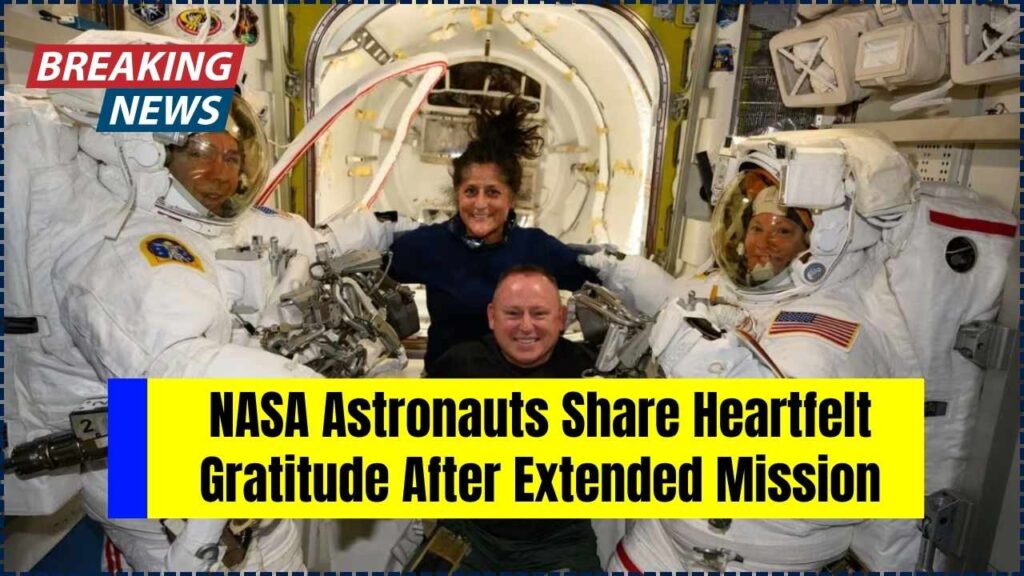
NASA Astronauts Share Heartfelt Gratitude: The NASA astronauts’ heartfelt gratitude after their extended mission aboard the International Space Station (ISS) has captivated people across the globe. Astronauts Butch Wilmore and Sunita (Suni) Williams recently returned to Earth following an extraordinary and unexpected 286-day mission in space. Initially intended to be a short, eight-day round-trip to test the Boeing CST-100 Starliner spacecraft, the mission was extended due to a series of technical setbacks that turned it into a record-setting adventure in endurance, trust, and human ingenuity.
Their return has become a symbolic moment in the evolving story of human spaceflight. The astronauts’ reflections are more than just post-mission protocol—they are emotional, raw, and deeply inspiring. They serve as a reminder of the determination and resilience required to push the boundaries of space exploration.
NASA Astronauts Share Heartfelt Gratitude
| Feature | Details |
|---|---|
| Astronauts Involved | Barry “Butch” Wilmore and Sunita “Suni” Williams |
| Mission Duration | 286 days (originally planned for 8 days) |
| Spacecraft Used | Boeing CST-100 Starliner |
| Main Mission Objective | ISS crew transportation and spacecraft testing |
| Key Challenges | Technical delays, prolonged stay, system diagnostics |
| Return Date | March 2025 |
| Longest Mission on Starliner | Yes |
| Official Website for Updates | nasa.gov |
The return of NASA astronauts Butch Wilmore and Sunita Williams after their extended 286-day mission aboard the ISS stands as a milestone in the evolution of human space exploration. Their strength, adaptability, and heartfelt gratitude reflect the best of what humanity can achieve when science, spirit, and collaboration intersect.
As we look to the future—with dreams of lunar bases, Martian soil beneath our boots, and commercial space stations orbiting Earth—this mission will serve as a foundational chapter. It teaches us not only how to survive in space, but how to thrive. Let their story inspire the next generation of explorers.
A Mission That Tested Human Limits
When Wilmore and Williams launched aboard the Boeing Starliner in June 2024, the goal was clear: conduct a short-duration mission to the ISS as part of final certification tests for NASA’s Commercial Crew Program. However, within days, engineers identified anomalies in the Starliner’s propulsion and environmental systems. Instead of returning after a week, the astronauts remained on the ISS as diagnostics and safety assessments were conducted.
The unexpected extension transformed the mission from a brief demonstration into a full-fledged long-term space assignment. NASA and Boeing agreed that ensuring safety was paramount, and it was better to keep the astronauts aboard the ISS—where they could live and work safely—until all Starliner issues were resolved.
“We just had to pivot, right? We were ready to just jump into it,” said Williams. “It wasn’t what we expected, but that’s spaceflight for you.”
Both astronauts resumed ISS operations seamlessly, contributing to experiments, station maintenance, and outreach programs, while also serving as critical test subjects for extended mission planning.
Gratitude in the Face of Adversity
Throughout the nearly 10-month stay, both astronauts remained composed and focused. Their training, combined with personal strength and the professionalism of NASA’s mission support teams, carried them through. In post-mission statements, Wilmore and Williams were quick to direct praise outward.
“We’re grateful not only for the folks in Houston and Florida, but for all those who kept believing in this mission,” Wilmore shared. “We knew they had our backs every single day.”
They highlighted the contributions of NASA’s engineers, flight directors, families, mental health experts, and even the public, who followed their journey with hope and encouragement. They also credited their fellow astronauts aboard the ISS for being supportive colleagues.
The astronauts’ gratitude extended beyond the agency. They acknowledged the global interest in their mission and the well-wishes from people around the world, demonstrating how space continues to unite humanity.
Leadership, Reflection, and Accountability
In their comments, Wilmore and Williams also reflected on the broader implications of the mission. Wilmore, a veteran astronaut and U.S. Navy captain, took a moment to express a rare public admission of shared accountability for the mission delays.
“I could have asked more questions. Maybe we all could have. There’s shared responsibility here,” he said thoughtfully.
He also emphasized the importance of leaders remaining transparent and decisive during critical times. The astronauts gave credit to former President Donald Trump and Elon Musk, recognizing their roles in keeping U.S. space programs visible and supported at the highest levels.
“Their support made a difference, especially when the public spotlight was intense,” Wilmore added.
This balanced perspective offered insight into how leadership, from mission control to the White House, can influence the course of space exploration.
Boeing Starliner: Trials and Trust in Technology
While the technical issues that extended the mission have prompted investigation, both astronauts expressed confidence in Boeing’s Starliner. The prolonged stay, though unintended, has provided NASA and Boeing with extensive data that could not have been obtained from a shorter test flight.
“We’re going to rectify the issues,” said Wilmore. “Starliner is going to be a big part of the future.”
Despite initial skepticism, the astronauts’ endorsement may help bolster public and institutional confidence in Boeing’s role in NASA’s commercial space strategy. NASA plans to integrate Starliner as a routine crew transport system alongside SpaceX’s Crew Dragon.
For detailed technical updates and mission outcomes, visit the NASA Commercial Crew Program portal.
Living in Microgravity for Nearly a Year
Spending nearly 300 days in a weightless environment demands physical and psychological resilience. Astronauts must maintain cardiovascular and muscular health through daily exercise, stick to disciplined nutritional routines, and engage in mental health check-ins.
“It’s about structure,” Williams noted. “You wake up, move, work, eat, and reflect. It becomes a way of life.”
The astronauts conducted dozens of scientific experiments, including those related to human physiology, botany, materials science, and AI-assisted robotic systems. These experiments will yield data that will help support missions to the Moon, Mars, and beyond.
The emotional challenges of long-duration spaceflight—missing family, coping with stress, living in confined quarters—were managed through regular video calls, psychological counseling, and team camaraderie.
What This Means for the Future of Spaceflight
The mission is a pivotal learning moment in the journey toward deep space exploration. While the stay was unplanned, it mimicked the length and complexity of missions envisioned for Artemis lunar landings and Mars habitation missions.
Key Takeaways:
- Redundancy in life-support systems is essential
- Software testing must continue even post-launch
- Astronaut adaptability is critical to mission success
- Multi-agency coordination must be seamless
These lessons will inform not only future Starliner flights but also mission designs for Orion spacecraft, lunar Gateway operations, and commercial low Earth orbit habitats.
NASA and Boeing’s Roadmap Post-Mission
A thorough debrief and post-flight review process is already underway. This includes:
- Rigorous re-analysis of Starliner’s flight and reentry systems
- Integrating astronaut feedback into future designs
- Simulating extended-mission scenarios in training centers
NASA has emphasized that transparency will guide their corrective actions. Boeing has pledged full cooperation and commitment to improving safety, performance, and reliability.
Dreaming of NASA? SEES Summer Internship 2025 Applications Are Open! Check Eligibility Criteria
NASA Postdoc Opportunity Alert: Apply for the 2025 Program – Check Eligibility Criteria!
The Public’s Response: Inspiration Across Generations
The astronauts’ return drew praise from educators, policymakers, and the public at large. Across platforms like YouTube, X (Twitter), and Instagram, tributes poured in.
“My class tracked your journey every week. You made space feel real for my students,” a middle-school teacher shared online.
NASA also reported record engagement with educational tools and mission tracking apps during the Starliner mission. From classrooms to boardrooms, the astronauts became symbols of perseverance.
FAQs On NASA Astronauts Share Heartfelt Gratitude
Q1. Why was the mission extended to 286 days?
A: Technical issues in the Starliner spacecraft meant it was not safe for immediate return. NASA opted to keep the astronauts aboard the ISS until all safety benchmarks were confirmed.
Q2. What is the significance of this mission?
A: It validated Starliner’s long-duration viability, provided critical data for commercial spaceflight, and simulated deep-space mission durations.
Q3. Are more missions planned for Starliner?
A: Yes. NASA and Boeing have confirmed that more crewed missions are scheduled after technical upgrades.
Q4. What was the astronauts’ mental health strategy?
A: Regular routines, emotional support from families, scheduled calls, hobbies like reading and photography, and strong team dynamics.
Q5. How did this mission influence NASA’s goals?
A: It emphasized the importance of real-time diagnostics, crew adaptability, and inter-agency coordination for future long-haul missions.







